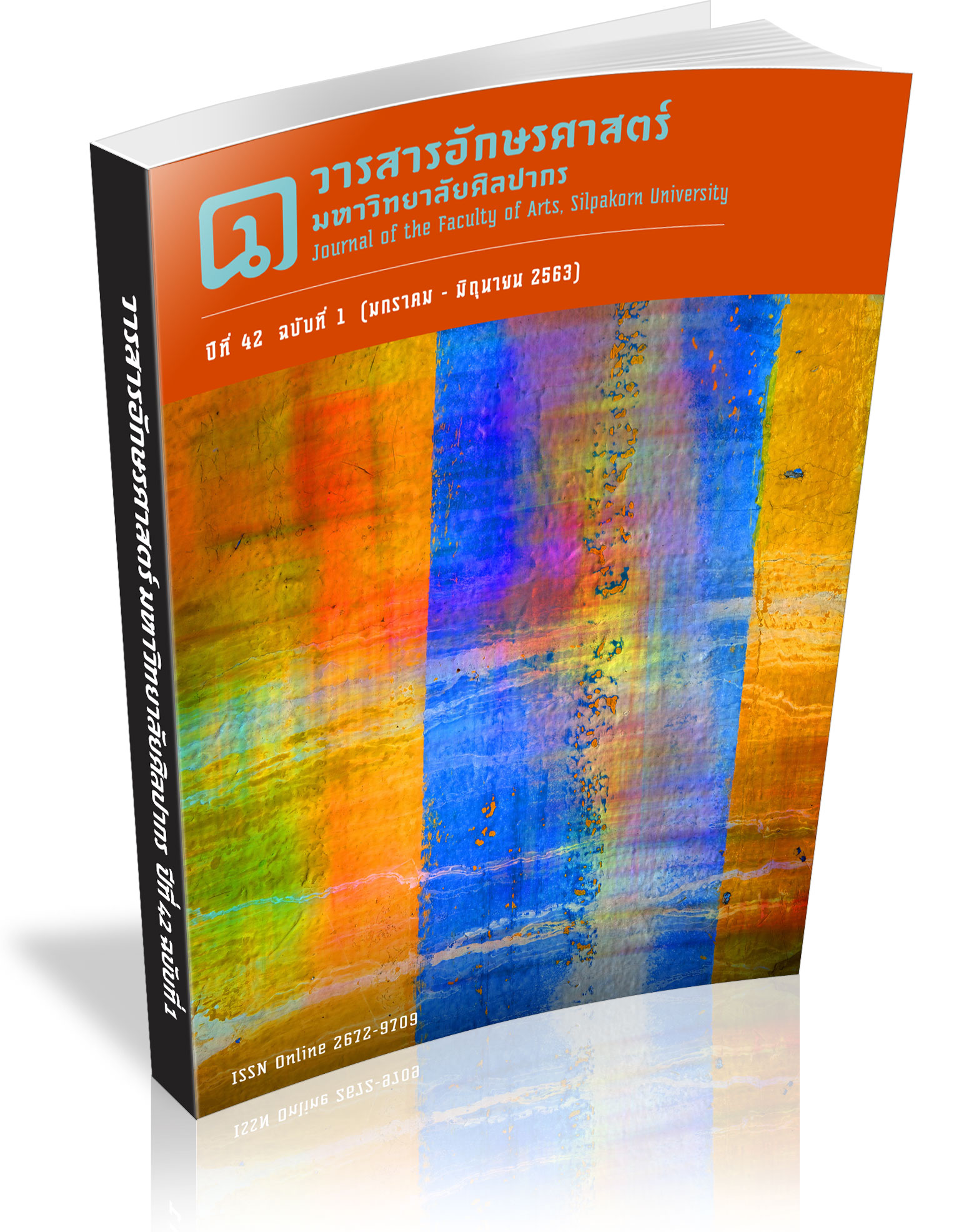The Image of the Barmaid in The Villon`s Wife by Dazai Osamu and Its Comparison with That of a Thai Teahouse Girl
Keywords:
Dazai Osamu, Barmaid, The Villon`s Wife, Teahouse girl, Japanese literatureAbstract
This article studies the images of Sat-chan and other female characters appearing in the Villon`s wife by Dazai Osamu. It is found that Sat-chan, Aki-chan, and Madam—the owner of the bar—all have financial power, and they are always supportive of Otani, the male protagonist. Occupation-wise, Sat-chan and Aki-chan are “barmaids”, and their occupation plays an important role in this novel. The Villon`s wife presents a positive image of the “barmaid” even though, at that period in Japan, the prostitution business was highly competitive and the “barmaid” was sometimes insulted by society. However, this was one of the occupations that young women dreamed of and it was regarded as a kind of the “Modern Girls’” career. It can be said that the author, having these characters becoming “barmaids,” wanted to portray the modern women under the patriarchal society, the independent women who had to struggle for survival in the dark and hopeless society after the end of World WarⅡ. The image is quite different from that of Thailand’s “teahouse girl”, who was definitely categorized as a prostitute, who had no influence whatsoever upon society, and who endured more contempt than the “barmaid”.
Downloads
References
Beautiful woman - teahouse girl –brothel, The legend of prostitute in Yaowarat. (2017). Retrieved 20 December 2019, from https://www.prachachat.net/facebook-instant-article/news-85517
Dazai, O. (1989). The complete works of Dazai Osamu No. 8. Tokyo: Chikumashobo.
Dazai, O. (1992). The complete works of Dazai Osamu No. 9. Tokyo: Chikumashobo.
Dazai, O. (2016). The Villon`s wife (P.Kitsomjed, Trans.). Bangkok: JLIT.
Dazai, O. (2017). No Longer Human (P.Kitsomjed, Trans.). Bangkok: JLIT.
Egusa, M. (1996). I, as a wife in The Villon`s wife. Kokubungaku kaishakuto kyoozainokenkyuu, 44(7), 87-93. (In Japanese)
Ikuta, M. (2012). Modangaaru Daizukan Taishoo Shoowa no oshare joshi. Tokyo: Kawade Shobo Shinsha Publishers. (In Japanese)
Ino, I. (1983). The study on The Villon`s wife, about the place of ethics. Studies in Japanese literature, 19, 165-175. (In Japanese)
Kamiya, T & O, H. (eds.). (1995). The encyclopedia of Dazai Osamu`s works. Tokyo: Bensei Publishing. (In Japanese)
Murashima, Y. (1929). Kanraku no ookyuu cafee. Tokyo: Bunkaseikatsukenkyuukai. (In Japanese)
Nohara, K. (1981). Dazai Osamu,Hito to Bungaku. Tokyo: Libroport Publishing. (In Japanese)
Rajadhon, A. (1969). Recall for the past vol.3. Bangkok: Suksit Siam.
Saowarat, S. (2019). Strolling around Bangkok, sipping tea, flirting with women, telling stories about prostitute city and famous shops 50 years ago. Retrieved 20 December 2019, from https://www.silpa-mag.com/history/article_24103
Sekine, J. (2012). A Study on "Villon's Wife" by DAZAI Osamu From the viewpoint of a wife who has "crosses the border". Bulletin of the Graduate School, Toyo University. 49, 1-14. (In Japanese)
Tanaka, M. (1990). "Villon's Wife", the others who are called “God”. Kokubungaku kaishakuto kanshoo, 55(7),156-166. (In Japanese)
Terazawa, Y. (2014). The Fluctuation of Sex Industry in 1930's Japan: The Significance of Employing and Labor System in Cafee. Memoirs of the Research Institute of the Cultural Sciences of Ritsumeikan University. 103,131-139. (In Japanese)
The association for women`s history. (2019). Japanese History of Female Labor: From Ancient to Modern. Tokyo: Bensei Publishing. (In Japanese)
Togoo, K. (2001). The discovery of female monologue, in The story called Dazai Osamu. (pp.113-135). Tokyo: Chikumashobo Ltd. (In Japanese)
Toyoda, K. (2014). The Modern Girl in Modern Literature. Journal of Bunka Gakuen University, The humanities & social sciences. 22,101-114. (In Japanese)
Tsuboi, H. (2002). Listening to the Women Who Talk- Dazai Osamu, Reconsideration of the female monolougue. Kaishaku to kyoozai no kenkyuu. 47(14), 21-27. (In Japanese)
Downloads
Published
How to Cite
Issue
Section
License
ผู้เขียนบทความต้องยินยอมในข้อกำหนดต่าง ๆ ของวารสารก่อนส่งบทความตีพิมพ์




